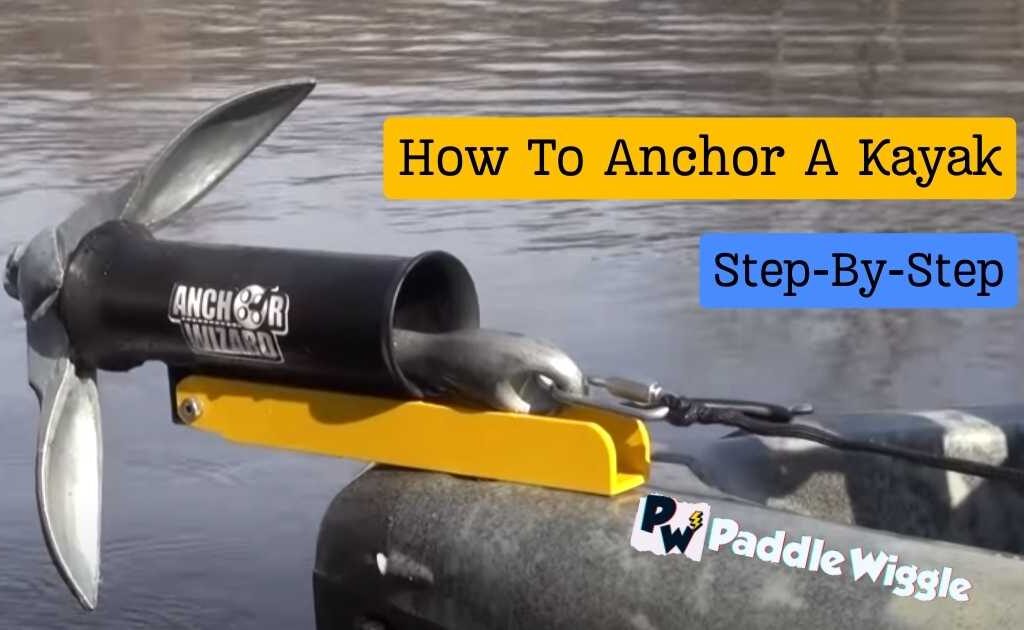Are you tired of feeling fatigued and uncomfortable during your kayaking adventures? It’s time to put an end to that struggle. The key lies in choosing the right size kayak paddle for your needs. A too-long or short paddle can greatly impact your performance on the water.
Using a shorter paddle might seem like a quick fix, but it can actually hinder your maneuverability and control. On the other hand, opting for the right size paddle ensures efficient strokes and optimal power transfer. This means less wasted energy and more enjoyable paddling.
Paddle sizing is a fundamental aspect of kayaking, influencing your stroke efficiency, comfort, and overall enjoyment on the water.
But how to measure kayak paddles? I mean how do you measure the right size for your paddle?
In this guide, we will walk you through the essential steps to accurately measure the ideal size for your kayak paddle.
Let’s explore the ins and outs of paddle measurement!
Contents
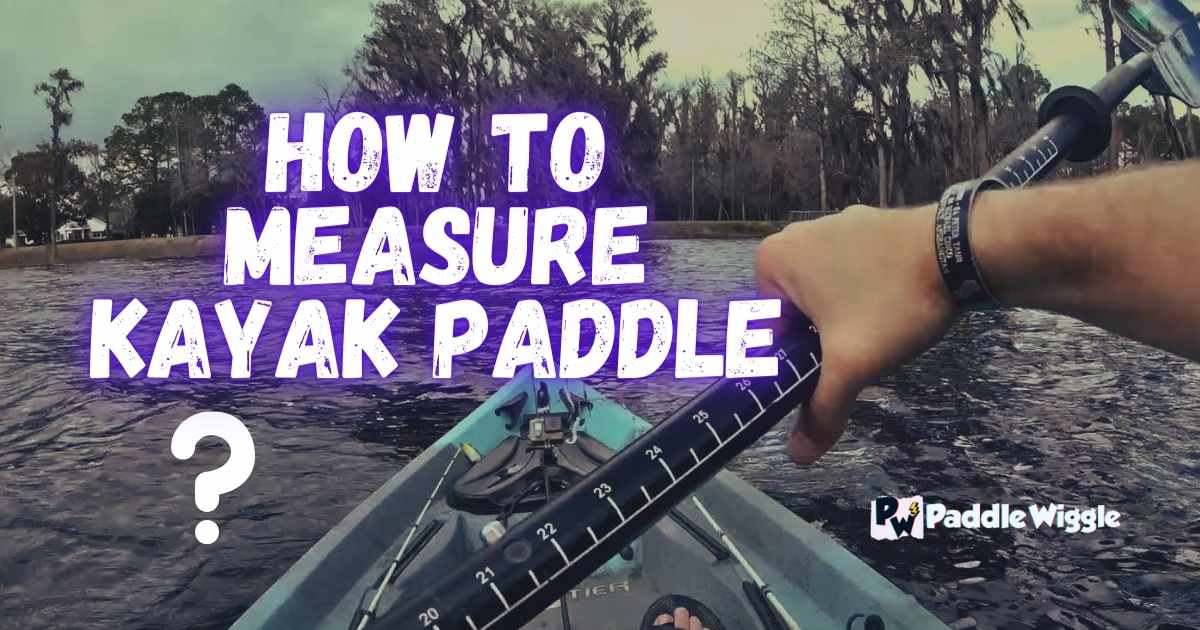
How Do You Measure Paddle Size For You And Your Kayak?
The right paddle size is crucial for a comfortable and efficient kayaking experience. One of the key factors to consider when measuring for the right paddle size is your torso height. Your torso height plays a significant role in determining the appropriate length of your paddle.
To accurately measure your torso height, it is important to do so from a seated position. Sit upright with your back against a wall or in a chair, ensuring that your legs are at a 90-degree angle.
Place a tape measure between your legs, extending it up along the spine until it reaches the base of your neck. This measurement will give you an accurate indication of your torso height.
In addition to torso height, body measurements such as arm span can also help determine the ideal paddle length for you. Arm span refers to the distance between fingertip to fingertip when arms are outstretched horizontally.
By comparing this measurement with your torso height, you can gain further insight into selecting the right paddle size.
To ensure optimal results when measuring kayak paddles, it is recommended to use a sizing guide specific to your kayak type. Different types of kayaks may require varying paddle lengths due to variations in width and seating position.
Here are some additional tips to keep in mind when measuring for kayak paddles based on torso height:
Short Torso:
- If you have a shorter torso, opt for a shorter paddle length.
- A shorter paddle allows for more control and maneuverability.
Average Torso:
- A paddle length within the standard range should suffice if you have an average torso height.
- Standard paddle lengths are typically between 210cm and 230cm.
Tall Torso:
- If you have a taller torso, consider using a longer paddle length.
- A longer paddle provides greater reach and efficiency when paddling.
The 3 Steps To Measuring The Right Paddle Length Of A Kayak
Finding the perfect paddle length is surprisingly easy when you follow these simple steps. The perfect paddle length not only ensures efficient strokes but also minimizes fatigue, allowing you to fully enjoy your time on the water.
Follow these three steps to make this easier for you:
Determine Your Preferred Paddling Style
Before diving into the intricacies of measuring a kayak paddle, it’s essential to determine your preferred paddling style. Do you enjoy a high-angle stroke, or do you lean towards a low-angle stroke? This decision will influence the length of the paddle that suits you best.
Measure Torso Height Accurately Using Recommended Techniques
Your torso height is the primary factor to consider when determining the right paddle length for you. A too-long or short paddle can lead to discomfort and inefficient strokes.
To determine the ideal length based on your torso height:
- Stand upright with your arms stretched above your head.
- Measure from the ground up to where your hands meet.
- This measurement will give you a good starting point for selecting an appropriate paddle length.
Consider Kayak Width When Selecting Paddle Length For Stability
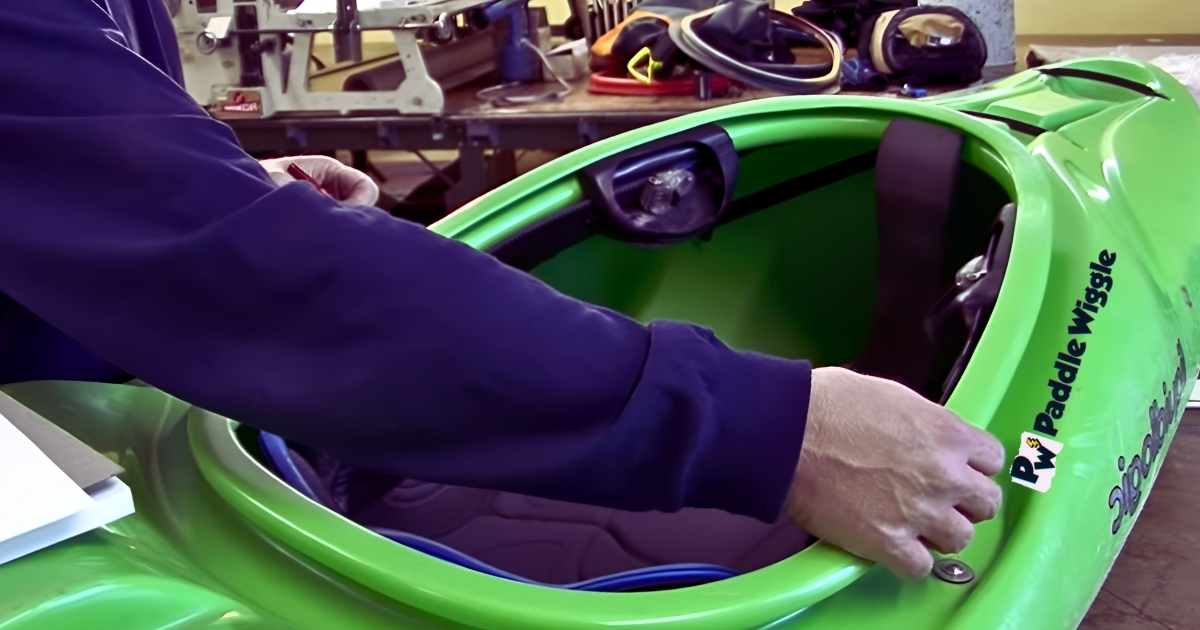

Another crucial factor in choosing the right kayak paddle length is considering the width of your kayak. A wider kayak requires a longer paddle to ensure stability and efficient strokes. On the other hand, if you have a narrower kayak, opting for a shorter paddle can enhance maneuverability.
Consider these guidelines when determining paddle length based on kayak width:
- Choose a longer paddle for wider kayaks (30 inches or more) to ensure sufficient reach.
- Opt for a shorter paddle for narrower kayaks (less than 26 inches) that allows for precise strokes.
Kayak Paddle Length For Height Chart


Finding the right kayak paddle length is crucial for a comfortable and efficient paddling experience. The length of your paddle will depend on your height, as it directly affects your reach and stroke mechanics.
Here’s a handy kayak paddle length chart based on your height and kayak’s width to help you choose the perfect paddle:
| Paddler’s Height (Feet) | Kayak’s Width (Inches) | Paddle Length (Inches) |
|---|---|---|
| Under 5’0″ | Up to 24″ | 190 – 200 |
| 24″ – 28″ | 200 – 210 | |
| 28″ – 32″ | 210 – 220 | |
| Over 32″ | 220 – 230 | |
| 5’0″ – 5’6″ | Up to 24″ | 200 – 210 |
| 24″ – 28″ | 210 – 220 | |
| 28″ – 32″ | 220 – 230 | |
| Over 32″ | 230 – 240 | |
| 5’7″ – 6’0″ | Up to 24″ | 210 – 220 |
| 24″ – 28″ | 220 – 230 | |
| 28″ – 32″ | 230 – 240 | |
| Over 32″ | 240 – 250 | |
| 6’1″ – 6’6″ | Up to 24″ | 220 – 230 |
| 24″ – 28″ | 230 – 240 | |
| 28″ – 32″ | 240 – 250 | |
| Over 32″ | 250 – 260 | |
| Over 6’6″ | Up to 24″ | 230 – 240 |
| 24″ – 28″ | 240 – 250 | |
| 28″ – 32″ | 250 – 260 | |
| Over 32″ | 260 – 270 |
Choosing The Right Paddle Length
Your height and the width of your kayak determine the right paddle length.
If you’re around 5’5″ and have a narrow kayak, a paddle between 190 to 210 inches is good. And if you’re around 6′ with wider kayaks, consider paddles between 230 and 250 inches.
And if you’re not sure, determine your height and check the section below.
- Under 5’5″ (165 cm): Paddles ranging from 190 cm to 240 cm are recommended for shorter individuals. These shorter paddles provide better control and maneuverability.
- 5’5″ – 5’11” (165 cm – 180 cm): If you fall within this height range, consider paddles between 210 cm and 250 cm long. This range offers a good balance between control and power.
- 6’0″ – 6’4″ (183 cm – 193 cm): Taller individuals should opt for paddles ranging from 220 cm to 260 cm. Longer paddles allow for greater reach and more powerful strokes.
- Over 6’4″ (193+ cm): For those above this height range, look for paddles measuring at least 220 cm up to around 270 cm. These longer paddles provide the necessary reach and power for taller individuals.
Remember, these guidelines serve as general recommendations. Personal preferences and paddling style may also influence your choice of paddle length.
So, you can try different sizes to find the one that feels most comfortable and suits your preferred kayaking.
Understanding Different Paddle Materials
Different materials offer varying levels of durability, weight, and cost. Understanding the differences in materials is crucial for finding the right one that suits your needs.
Here are some popular materials used in kayak paddles:
Carbon Fiber
Carbon fiber is a popular material choice due to its lightweight nature and excellent strength-to-weight ratio. Paddles made from carbon fibre are highly durable and provide exceptional performance in the water. They are often favored by experienced paddlers who value speed and efficiency. However, carbon fiber paddles can be more expensive compared to other materials.
Fiberglass
Fiberglass is another common material used in paddle construction. It offers a balance between durability and affordability. Fiberglass paddles are known for their moderate weight and versatility. They provide a good combination of strength and flexibility, making them suitable for various types of kayaking activities.
Polypropylene
Plastic or polypropylene paddles are an economical option for beginners or recreational paddlers. While they may lack the lightweight qualities of carbon fiber or fiberglass, plastic paddles are highly durable and resistant to impact. They are ideal for casual kayakers who prioritize affordability over high-performance features.
Types Of Kayak Paddle Blades
Blade shapes also significantly influence paddle design, impacting stroke efficiency and water displacement. There are several blade shapes available, each with its own advantages:
High-Angle Blades
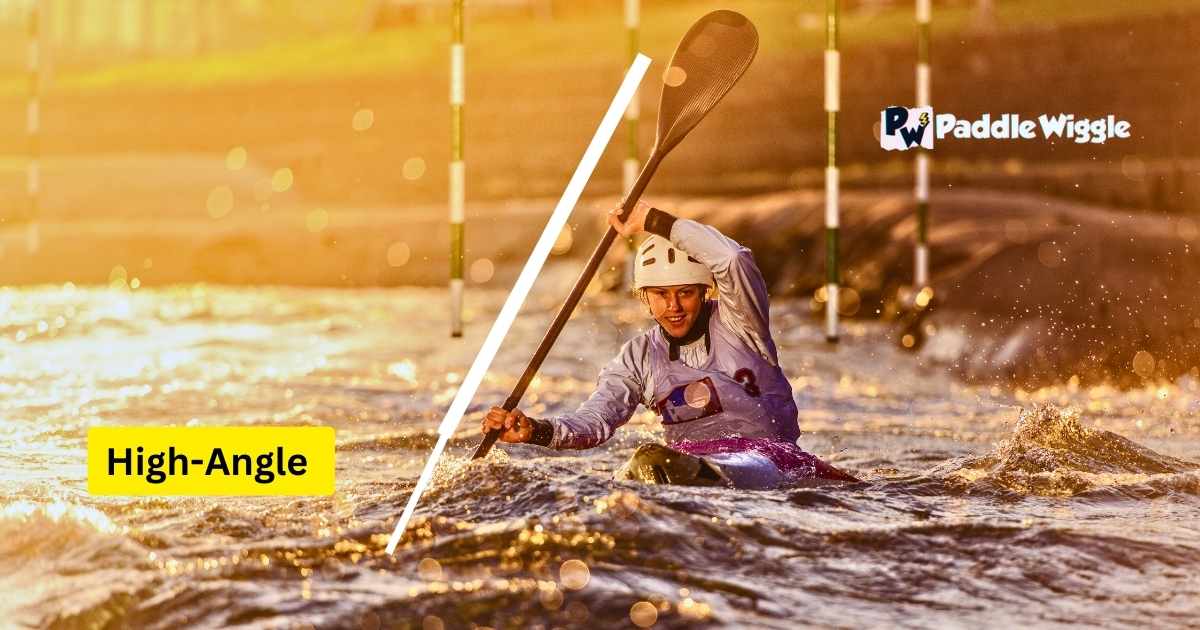

These blades have a wide surface area, allowing for powerful strokes with increased acceleration. They are commonly used by whitewater kayakers or those who prefer a more aggressive paddling style.
Low-Angle Blades


With a narrower shape, low-angle blades promote smoother strokes that require less effort while maintaining stability on calm waters. They suit recreational kayakers or individuals who enjoy longer trips where endurance matters.
Wing Blades
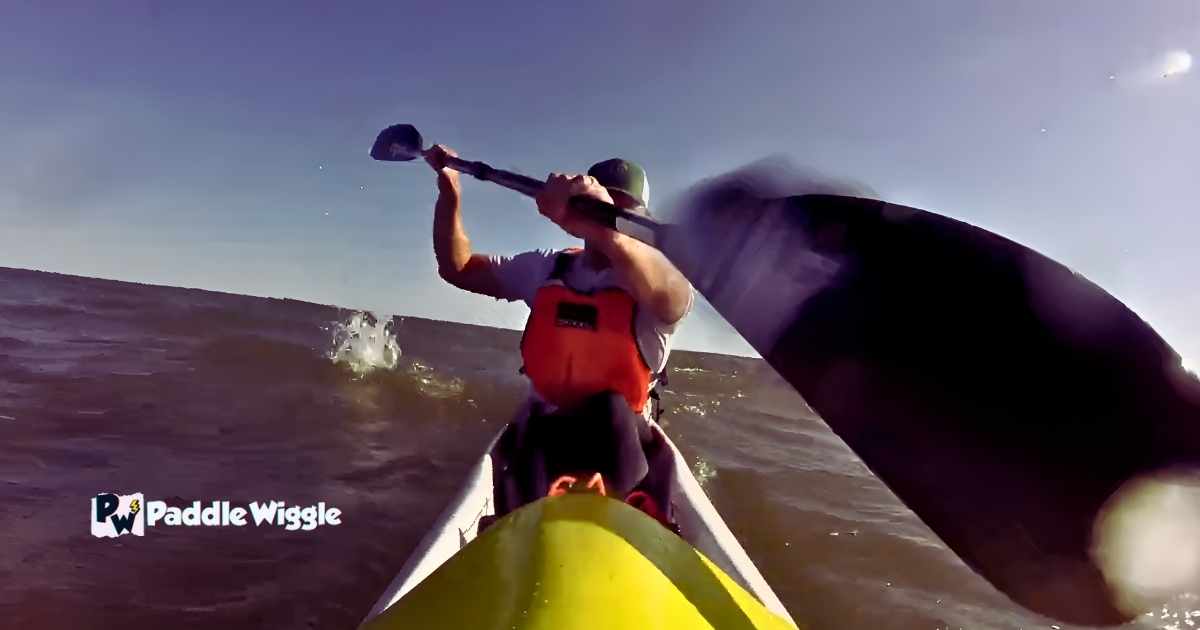

Wing blades are like super sleek paddles made for racing. They have a fancy shape that helps paddlers move faster through the water when they paddle forward. So, if you’re in a race and use these special blades, you can go really fast! But here’s the catch – you need to use the right paddling technique to make them work their best. If you practice and paddle just right, you’ll be flying across the water like a pro!
Paddle Shafe Designs
Shaft designs are another aspect to consider when selecting a paddle. The shaft directly affects grip comfort and overall paddle weight.
Here are some common shaft designs:
Straight Shaft
This traditional design offers simplicity and is suitable for most paddlers. Its straight shape provides a consistent grip, allowing for efficient power transfer during strokes.
Bent Shaft
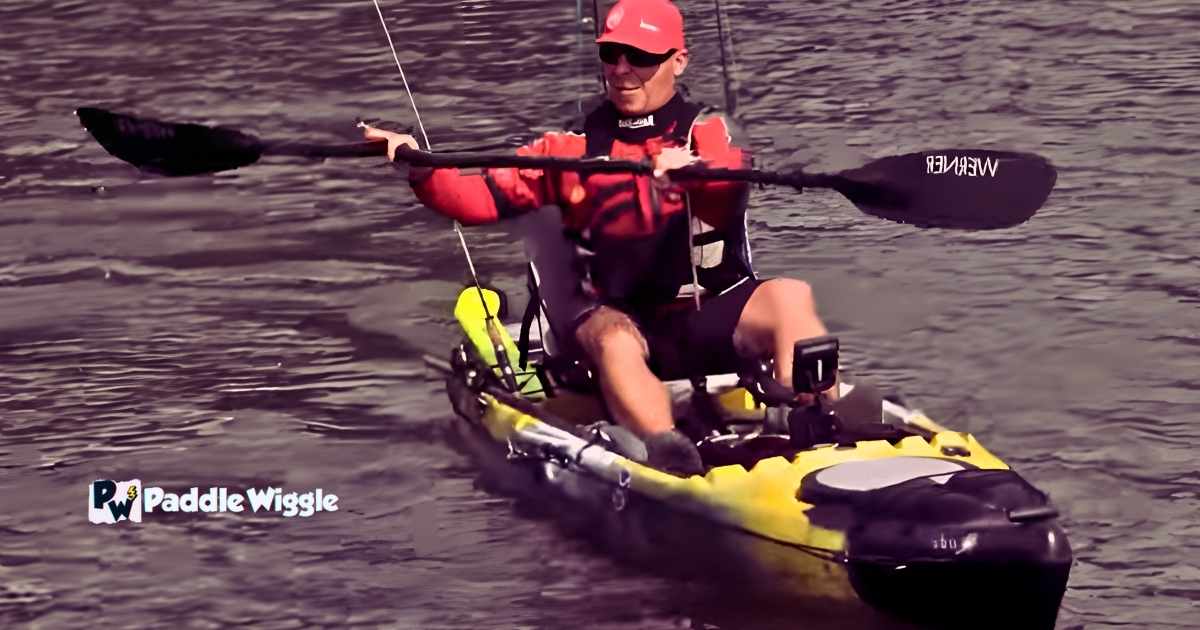

Designed with a slight bend in the middle, bent shafts provide ergonomic advantages by aligning the wrist and reducing strain during repetitive motions. They can enhance comfort, especially during long kayaking sessions.
Adjustable Shafts
These versatile options allow you to adjust the length of your paddle according to your preference or specific kayaking conditions. They are particularly useful when sharing a kayak with others or transitioning between different paddling activities.
Sizing Guide For Whitewater Kayak Paddles
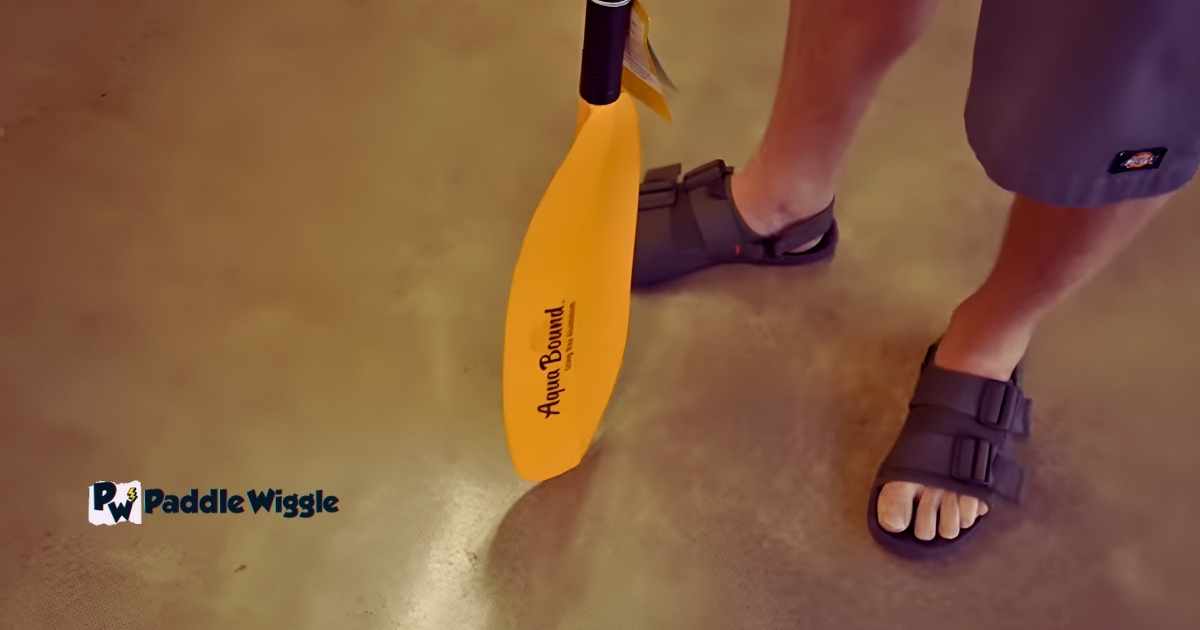

Having the right paddle size is crucial for optimal performance and maneuverability. In this guide, we will explore the key factors to consider when measuring a kayak paddle, specifically for adult whitewater kayakers.
Shorter Paddle Lengths Are Commonly Used In Whitewater Kayaking
Whitewater kayaking requires quick and agile movements to navigate through turbulent waters. As such, shorter paddle lengths are commonly preferred in this discipline. A shorter paddle allows for faster strokes and better control in tight spaces. It also reduces the risk of hitting rocks or obstacles during rapid descents.
When determining the ideal length of your whitewater kayak paddle, there are a few factors to consider. First, you need to take into account your height and torso length. Taller individuals generally require longer paddles, while shorter individuals may find shorter paddles more comfortable.
Another consideration is the width of your kayak. Wider kayaks typically require longer paddles to reach the water effectively. Conversely, narrower kayaks can be paired with slightly shorter paddles without sacrificing performance.
Blade Size Should Be Smaller For Quick Maneuvers
When paddling through rapids, the paddle blades’ size also matters. Smaller blades make it easier to do quick turns and move faster.
On the other hand, bigger blades give you more power, but they might feel heavy and slower in fast-moving water.
If you’re going on a whitewater adventure, it’s best to choose a paddle with relatively smaller blades that still work well to move you forward. The exact size will depend on what feels comfortable for you and how strong you are but try to find a paddle that gives you a good mix of being fast and having enough power.
This way, you can maneuver through the rapids smoothly and have a great time on the water!
Shaft Material Should Be Durable Enough To Withstand Impact
Whitewater kayaking exposes your equipment to various impacts from rocks and other obstacles found along the river. Therefore, it’s essential to choose a kayak paddle with a shaft made from durable materials that can withstand these forces.
Fiberglass and carbon fiber shafts are popular choices among whitewater kayakers due to their lightweight nature and exceptional strength. These materials offer excellent durability while minimizing fatigue during extended paddling sessions. However, they can be more expensive compared to aluminum or plastic shafts.
Fishing Kayak Paddle Sizing Guide
Choosing the right paddle length for fishing kayaks is crucial to ensure a comfortable and efficient paddling experience. Wide and stable fishing kayaks require longer paddles to avoid hitting the sides or leaning over with each stroke.
If your fishing kayak has an adjustable height seat and you plan to fish with it in the high position, you’ll need an even longer paddle. Use the chart above to gauge your ideal paddle length based on your height, kayak width, and seat height.
For instance, if you’re around 6 feet tall and your kayak is 32 inches wide, a 250 cm paddle would be a perfect fit for your fishing adventures.
Here are some key points to consider when measuring your kayak paddle length for fishing.
Longer Paddles Provide Better Reach From A Seated Position
As you sit in your fishing kayak, you’ll want a paddle that allows you to reach comfortably into the water without straining. Longer paddles offer increased reach, making navigating through different fishing spots easier and cast your line with precision.
Consider Paddle Length Based On Your Fishing Experiences
The width of your fishing kayak plays a role in determining the appropriate paddle length. Generally, wider kayaks require longer paddles. However, personal preference also plays a significant role in selecting the right size. Some anglers may prefer shorter paddles for maneuverability or longer ones for more power during strokes.
Paddle Blades For Efficient Fishing
When choosing a paddle, look for blade designs that prioritize efficiency and control while performing various fishing maneuvers. Fiberglass blades are often preferred due to their lightweight nature and excellent durability.
Steer Clear Of These 5 Paddle Sizing Mistakes For Kayaks
Paddle sizing is a critical aspect of a comfortable and efficient kayaking experience. Avoiding common paddle sizing mistakes ensures that you find the ideal paddle that complements your body, paddling style, and water conditions.
Let’s explore the top 5 mistakes to steer clear of when choosing a kayak paddle:
Overlooking Kayak Width
The width of your kayak significantly influences paddle sizing. A wider kayak demands a longer paddle to reach beyond the edges without hitting the sides during each stroke. Neglecting the kayak’s width may lead to discomfort and inefficient paddling.
Neglecting Water Conditions
Water conditions play a vital role in paddle sizing. Different conditions may require adjustments in paddle length to maintain efficiency and control. Overlooking water conditions can lead to improper paddle sizing, affecting your performance on the water.
Skipping Adjustment Features
Choosing paddles without adjustable features can be limiting, especially for paddling on different water conditions. Adjustable paddles offer flexibility and adaptability. This allows you to fine-tune paddle length according to different situations.
Forgetting About Blade Shape
Blade shape is an essential consideration when selecting a paddle. Different blade designs, such as dihedral or symmetrical, affect how efficiently the paddle moves through the water. Neglecting blade shape can impact paddling efficiency and technique.
Neglecting Paddling Technique
Your preferred paddling technique, whether it’s high angle or low angle, affects paddle length selection. Disregarding your paddling technique may result in a paddle that’s not well-suited for your style, leading to discomfort and reduced performance.
Finding Your Perfect Paddle Size: Balancing Kayak Width And Body Measurements
Considering the width of your kayak and your body measurements is crucial. The width of a kayak plays a significant role in determining the appropriate paddle length. Taking into account body measurements like arm span can help ensure optimal paddle sizing. Let’s dive deeper into these considerations:
Wider Kayaks Generally Require Longer Paddles For Proper Reach
If you have a wide kayak, it’s essential to pick a longer paddle that can reach properly and work well. A wider kayak needs a longer paddle so that the paddle can reach out beyond the edges of the boat. This way, you can put the paddle fully in the water without hitting the sides.
Just add a few inches to your height to find the right length for your wider kayak paddle. This helps account for the extra width of the kayak. When you’re paddling, your hands will be comfortably above the water, and you can enjoy your kayaking adventure!
Paddle Length According To The Arm Span
Body measurements play an essential role in finding the perfect paddle size. One useful measurement is your arm span, which refers to the distance between fingertip to fingertip with arms outstretched horizontally.
To measure your arm span accurately, stand straight with your arms extended sideways. Have someone measure from one fingertip across your back to another fingertip. Once you have this measurement, divide it by two.
The resulting number will give you an approximate starting point for choosing a suitable paddle length. Remember that personal preferences may vary; some paddlers prefer shorter or longer paddles based on their specific needs and comfort level.
Shorter Paddles Work Better For Narrower Kayaks Without Compromising Efficiency
In contrast to wider kayaks, narrower ones offer more flexibility. Due to their reduced width, these kayaks allow for shorter paddles while maintaining stroke efficiency.
- Here’s a detailed comparison of short and longer paddles.
You can choose a paddle length closer to your height for narrower kayaks without much concern for hitting the sides. This allows for a more compact stroke and increased maneuverability in tight spaces or rough waters.
Ensure Comfortable Paddling Without Hitting Sides
Regardless of your kayak’s width, ensuring that the paddle you select allows for comfortable strokes without hitting the kayak’s sides is crucial. You want to maintain a smooth and uninterrupted motion when paddling, avoiding any contact between the paddle blade and the boat.
To achieve this, consider not only the length but also the angle of the blade. A shorter paddle may require a slightly higher angle during each stroke to prevent contact with the kayak. Experiment with different angles and lengths until you find one that provides an optimal balance between reach, efficiency, and comfort.
Learn More
Can I Use The Same Paddle For Different Kayaking Activities?
Yes, you can use the same paddle for different kayaking activities. However, using specialized paddles designed for specific activities can give you better performance and comfort. If you often go fishing or do whitewater kayaking, getting dedicated paddles for those activities is a good idea. This way, you can enjoy the best experience while kayaking!
Is Torso Height The Only Factor To Consider When Sizing A Kayak Paddle?
No, torso height is important, but it’s not the only thing to consider when choosing a kayak paddle size. You should also consider other body measurements and what kind of paddling you like to do. Taking into account kayak width and your preferred paddling technique will help you pick the right size paddle for a better fit.
Are There Any Specific Recommendations For Measuring Kayak Paddles For Children?
When measuring kayak paddles for children, it’s important to consider their age, size, and skill level. It’s a good idea to get adjustable or shorter paddles for them. This way, the paddles can be changed as they grow and get better at kayaking.
Final Words
In conclusion, mastering paddle sizing is a crucial skill for every kayaker. It’s an essential step for optimizing your overall paddling experience. By considering body measurements, kayak width, and intended kayaking activity, you can find the ideal paddle size that enhances your paddling experience.

